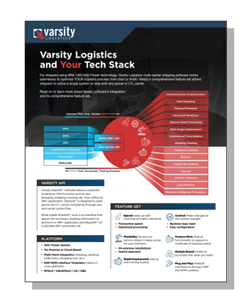
More Moving Parcels Equals More Costly Errors: The Importance of Auditing
Explore 3 key areas to audit in your shipping process for significant cost savings
Over the past several years, the surge in e-commerce has been record breaking. Year after year, it’s brought a significant increase in demand and volume for companies around the world. With more orders flooding in, businesses should be making more money, right? The reality is, however, that certain areas in your shipping process could be quietly draining your bottom line.
While e-commerce has transformed from a niche market to a dominant force, this rapid increase in shipping volume has pushed consumers to demand fast and reliable shipping. As businesses handle more products than ever before, the complexity of shipping logistics also grows. More parcels moving through the supply chain means more opportunities for costly errors.
Incorrect addresses, inappropriate shipping methods, and carrier overcharges are common areas where shipping errors occur, not only draining your resources but also impacting customer satisfaction. Each of these errors represents an opportunity for significant cost savings through careful auditing. By identifying and addressing these mistakes, businesses can streamline their shipping processes, reduce expenses, and boost their bottom line.
Let’s take a closer look at 3 areas in your shipping process that could be eroding your profit margins and why it’s crucial to audit them.
Address Accuracy and Validation
One of the most common and costly errors made in the shipping process is entering an incorrect address. Even the smallest mistake in an address can cause significant delays, misdeliveries, customer dissatisfaction, and additional charges. Missing an updated Zip+4 code or errors in spelling, spacing, or abbreviation are very common mistakes when it comes to wrong addresses.
When a parcel is sent to an incorrect address, or delivery is attempted to an address that doesn’t exist, carriers charge an address correction fee to provide the correct, deliverable address information back to you. For major carriers like FedEx and UPS, the average cost per address correction is $18-21 to the shipper. Also, if an address needs to be corrected, it automatically eliminates the on-time delivery guarantee, which can further damage the customer experience.
The Solution
Oftentimes, address correction fees appear on invoices without prior notice, making it challenging to anticipate and budget for these additional costs. That’s why it’s important to review your invoices and record any address changes for future shipments.
It’s also worth updating your database with corrected information for the future, or to consider shipping software that is already integrated with the United States Postal Service’s database. Ensuring your data is CASS-certified, meaning it uses the Coding Accuracy Support System (CASS) to check for accuracy against the USPS database, will significantly reduce the chances of address-related errors.
Another effective strategy is to implement multi-carrier shipping software that includes address validation features. Such software can automatically verify and correct addresses before shipping, reducing the likelihood of errors. This proactive approach not only saves money on correction fees but also ensures timely deliveries and enhances customer satisfaction. By auditing your shipping process for wrong address charges and employing these solutions, you can significantly cut down on unnecessary expenses and improve the efficiency of your operations.
Shipping Method and Rate Optimization
Another common reason for unnecessary shipping costs is using the wrong shipping method. Choosing an inappropriate shipping option can result in higher costs, longer delivery times, and additional surcharges. This problem is often due to a lack of awareness about the most cost-effective shipping methods and the variety of accessorial fees that carriers can impose.
Selecting the wrong shipping method typically occurs when employees are unaware of the most current methods, rates, and billing programs. Carriers offer a wide range of services that can differ in rates, delivery times, and conditions. For example, UPS has 10 different service levels with varying delivery timeframe options for sending a domestic package, while FedEx has 9 options for U.S. package and envelope shipping.
Choosing the wrong method can lead to unnecessary accessorial fees, such as:
- Dimensional (Length or Width) Overages
- Dimensional Weight Charges
- Collect on Delivery (COD) Fees
- Delivery Confirmation Fees (e.g., Signature Required)
- Delivery Reattempt Charges
- Inside Delivery or Pickup Charge
- Fuel Surcharge
- Third-Party Billing Fees
- Package Rerouting Fees (Phone request; Web Request)
- Delivery Area Surcharges (Remote Area; Metro Service Area; Residential Area; Alaska or Hawaii; International)
- Return Pickup Fees
- Saturday Delivery or Pickup Fees
While it’s easy to know if you should be looking at a Saturday rate based on the expected pickup or delivery date, it’s not always easy to know if you’re selecting the right service from the right carrier for the lowest price. The complexity and variety of options make it difficult to ensure that each package is shipped using the most cost-effective method.
The Solution
To address this issue, it is important to train employees to understand and select the most cost-effective shipping options. Employees should also be aware of new offerings for residential deliveries and how those prices compare with standard/saver delivery options with a residential surcharge. Regular training sessions can help keep your team up to date with the latest shipping methods, rates, and billing programs.
Additionally, using advanced shipping software that performs rate shopping can be a game-changer for your shipping operations. Rate shopping tools work by allowing you to enter your contract rates for each carrier and then automatically compare them to find the best shipping method based on your specific criteria such as fastest delivery, least expensive option, or to meet a specific delivery date. By implementing multi-carrier shipping software with a rate shopping tool or feature, you can avoid unnecessary surcharges and ensure that your shipping process is as efficient and cost-effective as possible.
Carrier Overcharges
Even with accurate addresses and the correct shipping methods, your invoices may still be higher than expected due to carrier overcharges. These overcharges can result from a variety of errors, including incorrect billing rates, unanticipated accessorial fees, and miscalculated weights or dimensions. Without careful monitoring, these charges can significantly erode your profit margins.
Carrier overcharges often stem from discrepancies between the agreed contract rates and the actual charges applied to your shipments. These discrepancies can occur for several reasons:
- Incorrect Rates: The carrier may bill at a higher rate than what was negotiated in your contract.
- Unexpected Fees: Additional fees for services such as residential delivery, fuel surcharges, or Saturday delivery may be applied incorrectly.
- Weight and Dimension Errors: Miscalculations of package weight or dimensions can lead to inflated charges.
- Duplicate Charges: In some cases, the same fee may be applied multiple times to a single shipment.
Manually auditing every invoice for these errors is time-consuming and prone to human error, making it difficult to catch all discrepancies. As a result, many businesses unknowingly overpay their carriers.
The Solution
To combat carrier overcharges, it is essential to implement a robust auditing process that can catch these discrepancies. Here are a few strategies to consider:
- Regular Invoice Reviews: Schedule routine audits of your shipping invoices to identify and dispute incorrect charges promptly.
- Contract Rate Awareness: Ensure your team is fully aware of the contract rates you have negotiated with your carriers. Keeping a reference document handy can help quickly verify whether the charges match your agreed rates.
- Dispute Mechanism: Establish a clear process for disputing incorrect charges with your carriers. Promptly addressing discrepancies can help recover funds and deter future errors.
- Training: Regularly train your staff to recognize common overcharges and understand the importance of accurate documentation and prompt dispute resolution.
Another option to avoid these overcharges is hiring a third-party service. These auditors conduct thorough line-item audits of your invoices for you, utilizing their expertise to uncover billing errors and ensure compliance with contracted rates. However, while these auditors can be helpful in finding the overcharges, they end up keeping a significant amount of money for their services. This strategy can be helpful for shippers in identifying leaks in their bottom line, but the cost-sharing aspect means it isn’t the most cost-effective option.
By implementing these strategies, businesses can mitigate the financial impact of carrier overcharges. While manual auditing and monitoring are essential, they can be labor-intensive and may not catch all errors. The good news is that there are advanced solutions available to streamline and enhance the accuracy of managing shipping costs.
The Winning Strategy: Automated Auditing Software
When it comes to auditing in the modern shipping landscape, the most invaluable option to combat overcharges is to implement automated invoice auditing as part of your comprehensive shipping software. This involves using specialized auditing functionality to review each line item on your carrier invoices, compare them against your contract rates, and rectify any discrepancies. Automated auditing software offers several key benefits:
- Accuracy: This software can precisely match billed rates with contract rates, ensuring no discrepancies go unnoticed.
- Efficiency: Automated processes can handle large volumes of invoices quickly, freeing up valuable time for other areas of your operations.
- Comprehensive Review: The software can detect a wide range of errors, from incorrect rates to unexpected fees and duplicate charges.
By integrating automated auditing as part of your shipping software, you can ensure that all overcharges are identified and rectified. This not only recovers lost funds but also provides valuable insights into recurring issues, allowing you to address the root causes and prevent future errors.
Introducing Varsity Logistics Auditing Solutions for IBM i
To effectively address the challenges of wrong address charges, incorrect shipping methods, and carrier overcharges, a robust, integrated solution is essential. Varsity Logistics offers automated auditing solutions as part of their advanced supply chain execution modules, with ShipAudit for parcel and FreightAudit for freight shippers. Both solutions provide a comprehensive toolset designed to streamline your auditing process and maximize your savings.
ShipAudit
The ShipAudit module is integrated with Varsity’s ShipSoft parcel shipping and rate shopping software. With ShipAudit software, all overcharges are credited back to your company, not just half. Plus, having the shipping software gives you the tools you need to validate addresses in advance, keep your database up-to-date, and to find the best rates to satisfy your customers.
ShipAudit integrates address validation features to ensure accurate deliveries and minimize wrong address charges. Through sophisticated rate shopping capabilities, ShipAudit identifies the optimal shipping methods, reducing the risk of using incorrect options and avoiding unnecessary surcharges. Additionally, its automated invoice auditing functionality meticulously reviews each line item against contracted rates, swiftly identifying and rectifying carrier overcharges. This comprehensive approach not only streamlines shipping operations but also enhances cost-effectiveness across the board.
FreightAudit
For Varsity’s ShipSoft-Freight users, FreightAudit offers an advanced solution tailored for freight shippers to automate and streamline the auditing of freight bills. Designed to reconcile estimated costs with actual billed carrier costs, FreightAudit ensures accuracy and cost control across less-than-truckload (LTL), truckload (TL), and rail shipments.
FreightAudit automates the entire freight bill audit process by comparing carriers’ actual invoices with pre-negotiated rates and anticipated costs generated at the time of shipment. This meticulous comparison includes tariffs, accessorial charges, and incentives to ensure accurate billing. When bills fall within the user-defined area, FreightAudit authorizes payment automatically. In cases where discrepancies occur, bills are flagged for review, rejected, or short paid, minimizing errors and avoiding overpayments.
Take the Step to Eliminate Costly Errors
In today’s competitive logistics environment, controlling costs and optimizing efficiency are crucial to achieve and maintain success. Taking the step to address challenges such as wrong address charges, incorrect shipping methods, and carrier overcharges requires proactive strategies and advanced solutions.
Whether you’re managing parcel shipments, overseeing complex freight logistics, or both, incorporating robust auditing capabilities into your shipping software not only mitigates financial risks but also enhances overall supply chain performance. With real-time monitoring, precise invoice reconciliation, and seamless integration capabilities, Varsity Logistics’ industry leading shipping software, complete with integrated auditing solutions, empowers businesses to stay competitive in a rapidly evolving marketplace.
Ready to eliminate costly errors and automate your auditing process? Reach out to our team of Varsity Logistics shipping experts to learn more about how our top-tier shipping solutions for IBM i (AS/400) shippers can transform your operations and bring in significant savings.







